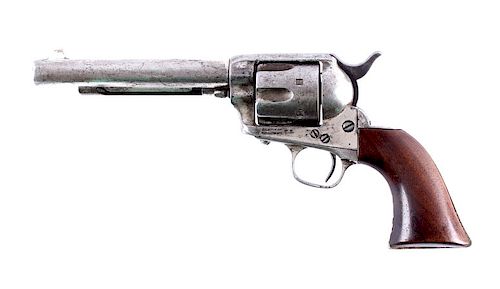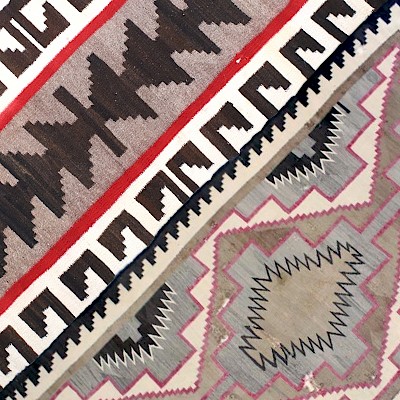Battle of Little Bighorn Arikara Scout US Colt SAA
Two ways to bid:
- Leave a max absentee bid and the platform will bid on your behalf up to your maximum bid during the live auction.
- Bid live during the auction and your bids will be submitted real-time to the auctioneer.
Bid Increments
| Price | Bid Increment |
|---|---|
| $0 | $5 |
| $50 | $10 |
| $100 | $25 |
| $500 | $50 |
| $1,000 | $100 |
| $2,000 | $250 |
| $5,000 | $500 |
| $10,000 | $1,000 |
| $25,000 | $2,500 |
| $100,000 | $5,000 |
About Auction
Aug 3, 2019
You are invited to our premier August Collector Sale. The sale will include some of our finest American Indian antiques, various classic cars and advertising signs. North American Auction Company tucker@naabid.com
- Lot Description
The lot features a Colt Single Action Army US 7TH Cavalry revolver issued to the Arikara Scout, Charging Up The Hill and signed in Togia Language Carvings. The pistol was owned and carried by Charging Up The Hill into the Battle of the Little Bighorn. It is believed that this pistol was part of the 115 revolver Special Government Sale obtained by General George Armstrong Custer through General Terry’s Order Number 117, which started before the Black Hills Expedition to allow Custer to outfit the 7th Cavalry and his Scouts in time for the Expedition. Some of the items were not shipped in time for the Expedition, but were later used for the Sioux Wars. The revolvers were sent to Shuyler, Harley and Graham with H&D Folsum Co. of New York being a partner. They were ordered to be nickel plated by Custer so that they would be able to be differentiated from the Cavalry Soldier issued pistols (which had a blue finish). They also received the wood grips, with some receiving Ivory grips, to be marked by the Arikara Scouts per Custer’s orders. They were then shipped to Fort Abraham Lincoln. Wendell Grangaard, Battle of the Little Bighorn Historian and Togia Language carvings expert, personally reviewed the duplicate records from the Fort’s Archives from two of the Ordnance Captains, not being allowed to make copies he wrote down all of the information of which serial numbers were shipped. It is known that Custer issued nickel plated Colt SAA revolvers as shown by the photograph taken by William H. Illingworth and developed by Buckbee-Mears Co. Lindeke Bldg., St. Paul, Minnesota, Coded 77837. This photograph shows Moses Milner “California Joe” with General George Armstrong Custer, along with Little Sioux, Bloody Knife, and Goose (Custer Scouts) each holding the Colt Single Action Army’s with nickel plating that Custer issued them from the shipment on July 29, 1874 by H&D Folson to Fort Lincoln. It also should be noted that a full blooded Indian Scout would not have been able to purchase a new revolver from a gun shop due to his heritage. In addition to the excellent historic documentation that this pistol was included in the Fort Lincoln firearms shipment to Custer the Colt is also signed in Togia Language carvings. The pistol has been examined and authenticated by Togia language expert, Wendell Grangaard of The Guns of History, Inc. The revolver was found to show hand carved symbols in the Togia Language. Marked across the back-strap butt metal frame, “Scout-Charging Up The Hill-rode with-brought messages-soldier, Boy Chief-Bear Running in Timber.” Marked on the bottom of the left grip bear back strap frame butt with the two societies that Charging Up The Hill belonged to, the New Dog Secret Society and the Grass Dance Secret Society. The right side of the grips are marked, “Head Chief Leader Running Wolf rode with Strikes Two.” On the left grip is marked, “Young Hawk – New Dog Society – Soldier.” The name “Black Fox” is written in Togia on the trigger guard. On this revolver, Charging Up The Hill is marking a tribute to the small group of seven scouts that he belonged to which was selected to carry the mail. Boy Chief also carried a nickel-plated US marked Model 1873 Colt SAA Revolver with S/N 13537 and Soldier carried an 1873 Winchester Carbine S/N 189. Included in the documentation with this lot is a copy of the Colt Manufactuing Company factory letter for the Colt Single Action Army Model 1873 with serial number 13721 being only a few serial numbers away from our own. The paperwork shows this as also being a Shuyler, Harley and Graham circa 1874 issue pistol and as a “Gov’t Sale” part of a 115 gun shipment. The Colt with serial number 13721 has been found to belong to One Horn, also a Custer Arikara Scout at Battle of the Little Bighorn. Also included in this lot is the book, “The Arikara Narrative of Custer’s Campaign and the Battle of Little Bighorn” by Orin G. Libby University of Oklahoma Press 1981. This is a Colt Single Action Army revolver with serial number 13725, manufactured in 1874 as part of the Government Sale. The revolver shows traces of the original nickel finish along with the original wood grips showing Togia carvings. The barrel has been shortened from its original 7.5” length to a crooked 5.75” along with a different front sight installed, possibly done by Crazy Horse’s gunsmith. Left side marked, “PAT. SEPT. 19, 1871 / PAT. JULY, 2, 1872”, “US”. Top marked, “COLT’S PT. F. A. MFG. Co. HARTFORD CT. U.S.A.” Also marked with the serial number 13725 on the trigger guard, receiver frame, and butt along with 3725 on the cylinder wall. Charging Up The Hill was an Arikara Native American Indian and enlisted as an Indian scout on May 8, 1876 with the 7th Cavalry. The piece comes with the signed letter describing the piece’s history from Wendell Grangaard along with a detailed illustration showing the markings he has translated. Wendell Grangaard is the foremost knowledge on the Togia language along with the Battle of the Little Bighorn as he is the author of the book, “Documenting the Weapons Used at Little Bighorn” 2015. Wendell was also intricate in the authentication and examination of the historic George Armstrong Custer Captured Sharps Carbine from Chief Black Kettle that sold at auction for $127,000. Comes with documentation including a detailed description authenticating the piece signed by Wendell, along with a illustration showing the togia language carvings drawn. This is truly one of the most important firearms made available for sale from the Battle of the Little Bighorn and the most important Arikara Scout Charging Up The Hill owned historic piece ever brought to the public. From the outstanding Historic Billings, Montana Indian Artifact Collection, the same collection as the Battle of the Little Bighorn Tomahawk, small axe, and other wonderful pieces brought to auction by our company. The firearm also comes with an appraisal from Wendell Grangaard placing the value between $60,000 and $90,000.For a complete representation of condition and for additional images please call 800-686-4216. It is the buyer’s responsibility to view each image and preview the item to determine condition.
Condition
- Shipping Info
-
North American Auction Company is proud to announce the opening of our new in-house, full-service shipping department. We have listened to you the customer and will now be handling all outgoing packages in our new shipping department. We are confident this new offering will allow for a smooth transition from auction block to your front step. We have partnered with preferred carriers to ensure a safe, efficient delivery that works best with your schedule. Please allow 14-21 days after complete invoice payment is made to package and ship your purchase. After you are notified of your winning bids from our company and your item invoice is paid in full our new shipping department will contact you. Make sure when signing up with our company that your preferred shipping information is up to date as this information will be used to estimate shipping cost. Once the items have been packaged our team will contact you for shipping payment. Shipping invoices and payment will be completely separately than the items invoice. Please notify the shipping department with any alternate request or instructions at mark@northamericanauctioncompany.com or 800-686-4216 ext. 3. For a shipping quote please contact the same information above. PLEASE NOTE a shipping quote price can fluctuate in price. Auction company is not responsible for actual shipping cost being higher than quoted shipping cost. Thank you for trusting North American Auction Co. with your bids and shipping. As our shipping department is brand new please understand that delays can be expected.
-
- Buyer's Premium



 EUR
EUR CAD
CAD AUD
AUD GBP
GBP MXN
MXN HKD
HKD CNY
CNY MYR
MYR SEK
SEK SGD
SGD CHF
CHF THB
THB









































